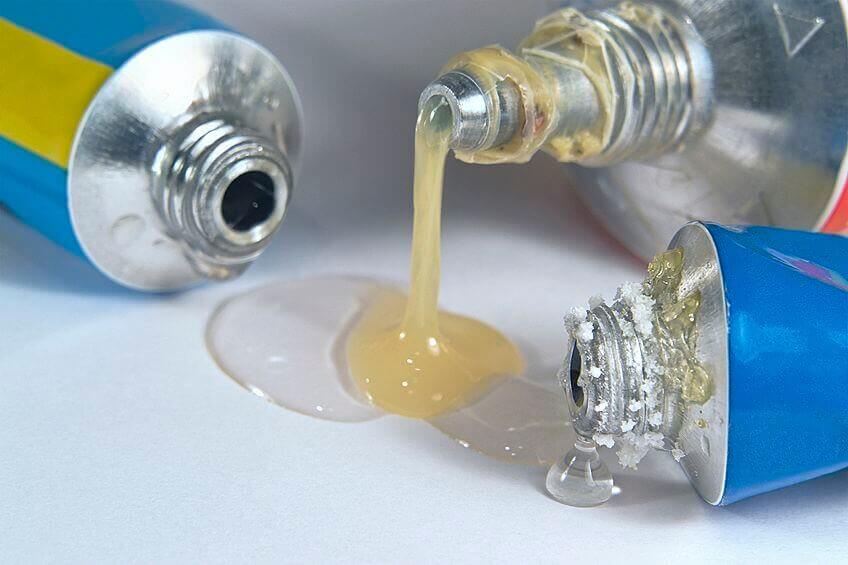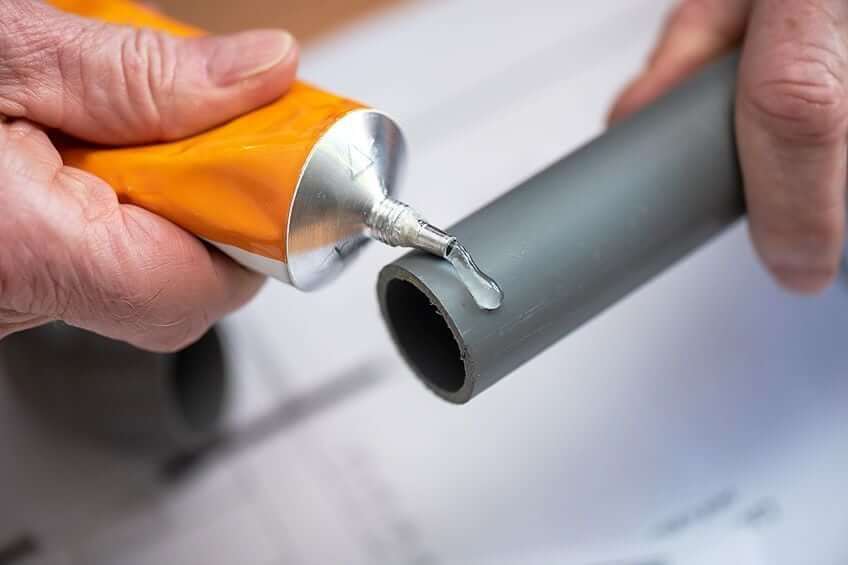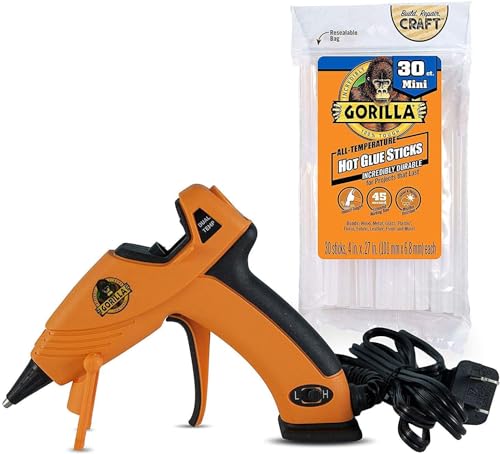Every adhesive is formulated to work with a specific material or set of materials. For instance, wood glue is chemically designed to penetrate the porous wood surface to bond.
Plastic, on the other hand, has a smooth surface with no pores. If you have a woodworking project involving plastic and wooden components, can you use wood glue to attach the materials? Does wood glue work on plastic?
Knowing whether the adhesive will create a strong bond between plastic and wood should be your first step to a successful project. Read along to learn how to attach plastic to plastic or plastic to wood using adhesives.
Can I Use Wood Glue on Plastic?
You can use wood glue on plastic, but it may not work properly. Wood glue does not work on plastic due to its chemical formulation that requires penetrating the wood to create a powerful bond. Plastic is neither porous nor water-absorbent, hindering its ability to bond with the glue.
So even though there are multiple types of wood glue, most of them are not suited for plastic objects. The glue cannot soak into the smooth plastic surface, which keeps it from bonding properly.
What is the Best Glue for Wood to Plastic?
The best adhesive for wood to plastic is epoxy. Epoxy glue sticks to virtually every type of plastic and wood. It creates a very strong bond once it is hardened.
It is an excellent adhesive, especially when working with an unknown type of plastic. Super glue is equally useful and possibly everyone’s default option for sticking together nearly any material.
However, super glues have their limitations when plastic is involved. For instance, they can burn some plastic types, leaving epoxy as the better alternative.
Nonetheless, here are the various options for gluing wood and plastic together.

Gluing wood to plastic using cyanoacrylate
- GEL FORMULA: No run control gel formula that is great for use on vertical surfaces
- ANTI CLOG CAP: Helps keep the glue from drying out. It's Gorilla tough use after use.
- IMPACT TOUGH: Specially formulated for increased impact resistance and strength
Cyanoacrylate is the formal term for super glue. It is considered a super adhesive because it can form a rock-hard bond within seconds. It is the fastest drying adhesive available and a suitable glue for wood and plastic.
This type of glue uses anionic polymerization in its bonding mechanism, unlike most adhesives that rely on evaporation. This special mechanism involves forming a chemical bond when the glue comes into contact with water hydroxyl ions.
You do not have to wet a surface to make the glue work. It typically relies on the moisture in the air to form its bond. This means cyanoacrylate can form a powerful bond between just about any surface.
Still, super glue has its limits. For example, it does not work too well with hard, smooth plastic surfaces. So, it is recommended to scuff up the smooth plastic surface with sandpaper before applying the glue for optimum results.
Gluing plastic to wood using epoxy glue
- Easy-to-use self-mixing dispenser and precision applicator
- High-strength formula bonds wood, metal, tile, ceramic, glass, plastic and more
- Waterproof, sand able and paintable
You will be hard-pressed to find any surfaces that epoxy cannot bond together. The adhesive typically comes in two tubes with connected or separate plungers. The plunger design can differ from one brand to another.
The design notwithstanding, the mechanism remains the same. One tube normally contains a resin, while the other is filled with a hardener.
To use the adhesive, you need to push out the contents of each tube onto a surface to combine them. Once the resin combines with the hardener, they form a tough, durable, and water-resistant glue.
This adhesive works perfectly for a wide range of surfaces, including metal, wood, ceramics, plastic, and rubber. Most epoxies will create incredibly strong bonds in under ten minutes.
However, others can require over two hours of clamping to work properly. Such slow-drying options can take up to 12 hours to dry and two days to be fully cured.
So, the rule of thumb is to find out about the drying time before purchasing one and follow the manufacturer’s recommendations to the letter for best results.
Contact cement
- This product is a 3Oz Bott Contact Cement
- Purpose of use for Caulk & Sealants, contact-cements
- Manufactured in China
Contact cement is a glue that works for most surfaces and is relatively easy to use. It forms a very strong, flexible bond that is permanent when used correctly.
Perhaps the most important aspect of using contact cement is that it requires a big surface area to create a strong bond. As such, you may want to consider the other options if you are attaching only a small plastic surface.
To use this adhesive, apply a thin layer on both parts you intend to join together. Then let it sit for one to two minutes before attaching them. The glue should be slightly tacky but dry to the touch after the two-minute wait.
Next, carefully align the glued parts and press them together to stick. Ideally, the joined parts should adhere to each other as soon as they make contact.
Do not put the item to use until at least 12 hours later; that is the amount of time the adhesive needs to cure.
Hot glue
- Glue gun features: Dual temp, precision nozzle, easy squeeze trigger, enhanced safety features, built-in stand, wide base, Do not pull glue sticks from glue gun. If changing glue, feed remainder of glue stick through glue gun.
- Gorilla hot glue sticks: Weather resistant for indoor and outdoor use, safe for both high & low temperature glue guns, 45 second working time, impact tough
- Gorilla Mini Dual Temp Glue Gun uses mini sized glue sticks (. 27" Diameter)
Hot glue is another good adhesive for plastic to wood. It is popularly used to stick or attach arts and crafts pieces. However, it does not work on some types of plastic, particularly heat-resistant ones.
Additionally, it should not be used on outdoor projects that will remain exposed to the sun. The heat from the sun will likely melt the hot glue from prolonged exposure.
Melting the glue can weaken the bond between the attached surfaces, potentially causing it to break. To use hot glue, apply it to the plastic scorching hot, then quickly press it down on the wood at the designated point of attachment.
You must make the plastic very hot with the glue for it to work. Be sure to hold it down till it has cooled down. This entire process should take only a few minutes, and the bond will have formed.
While hot glue is suitable for bonding plastic to wood, it is not the best glue for this purpose. However, it should do the work in most cases.
Polyurethane glue
- ORIGINAL GORILLA GLUE: The water activated polyurethane formula expands into materials to form an incredibly strong bond to virtually anything
- 100% WATERPROOF: Doesn't break down when exposed to outdoor elements
- VERSATILE: Easily bonds wood, stone, metal, ceramic, foam, glass, concrete and much more
Polyurethane is an excellent adhesive to bond wood to plastic. It forms a stronger bond than superglue is used correctly. Polyurethane is particularly ideal for gluing PVC to wood.
Polyurethane is also relatively weather-resistant, making it a glue of choice for outdoor projects. Its waterproof quality will come in handy in humid weather or wet environments.
To use polyurethane glue successfully, ensure you clean each surface to be attached before gluing them. We recommend letting the surfaces dry if they are wet from cleaning, then scuff sand them with fine-grit sandpaper to improve adhesion.
After sanding, wipe the sanding dust with a damp, lint-free cloth and apply the polyurethane immediately afterward. The adhesive requires moisture to create a chemical reaction that helps it bond properly.
So you must apply it while one of the surfaces is moist. Ideally, dry one surface and slightly dampen the other, then apply the polyurethane glue to the dry surface.
Next, clamp both surfaces for up to 24 hours to distribute the glue evenly and create a strong bond.
How to Glue Wood to Plastic
You can glue wood to plastic by using super glue, polyurethane glue, contact cement, hot glue, or epoxy. Nonetheless, epoxy is the best glue to attach plastic to wood.
It works on nearly all types of plastic and creates a robust bond. It also adheres excellently to all wood types, creating a very strong bond once cured.
Tips to Glue Plastic to Wood
You need an adhesive that works with plastic and wood when gluing plastic to wood. The first challenge is finding a glue that will bond with these different types of surfaces.
For instance, wood glues are designed to soak into the pores on wood, so they will not adhere to plastic. For this reason, they would not be a good choice of glue for a project involving plastic and wood.
That said, here are some tips to give you the desired results.
- Follow the manufacturer’s specific recommendations on drying time, clamping time, and surface conditions such as sanding before application. These will help you achieve the best results on your project.
- Choose your glue based on the scope of your project. For example, use contact cement adhesive only if your project involves sticking large surfaces together. Consider other options such as super glue or epoxy for smaller surface areas.
- Always invest in a higher-quality adhesive when working on expensive items.
- Always wear sturdy, protective hand gloves when using super glue. Otherwise, it can bond to your skin in seconds.
- When using high-strength adhesives, work in a well-ventilated area since they can produce toxic fumes that you do not want to inhale.
- Always wear protective eyewear when using fumy adhesives that might hurt your eyes.
Does Gorilla Wood Glue Work on Plastic?
Gorilla wood glue contains polyurethane as a key ingredient in most of the products, so it will work on some plastics. You can always resort to Gorilla wood glue when working with textured plastic.
However, like most wood adhesives, glue is primarily formulated for wooden materials, not plastic. So you can expect the quality of its adhesion to be less than ideal on plastic.
One of the main ingredients in Gorilla wood glue is polyvinyl acetate or PVA. This ingredient is specifically designed to bond with porous materials like wood and paper.
This explains why the polyurethane in Gorilla wood adhesive will do little to make the glue form a strong bond on a plastic surface.
The Gorilla glue manufacturer also recommended not using the product with polyethylene or polypropylene plastics. You should also avoid using it on rubber with a high plasticizer or oil content.
How Long Does Super Glue Take to Dry on Plastic?
Super glue dries and hardens the moment it touches the surface of a plastic or any other material. This special kind of adhesive has a chemical formula that reacts with any level of water to create a bond.
Water is typically present in the air in the form of humidity, so objects always have some water on their surfaces. As soon as the glue comes in contact with this water, it quickly reacts and hardens.
The entire process can take less than 30 seconds, depending on the project size. Cyanoacrylate then takes about 24 hours to cure completely.
So even though your attached surfaces will bond almost instantly, you need to give it up to a day to reach full strength to be ready for normal use.
Read more: How Long Does it Take Glue to Dry
How Do You Glue Two Pieces of Plastic Together?
Various kinds of plastic will work best with different levels of adhesive strength. So if you want to glue two pieces of plastic together, start by finding the appropriate glue strength for that specific plastic.
You should find the information etched on the packaging of the plastic itself. Reading about the material should give you the information you need.
Once you have identified the adhesive level, clean the parts you intend to stick together or the entire pieces of plastic. Next, you may scuff up the surfaces with fine sandpaper to improve adhesion further.
This surface preparation should remove any dirt or grime on the plastic, making it easier to stick. Now you can apply your chosen glue with its tube or a synthetic bristled brush.
In most cases, it will be best to use the tube to apply the glue, for instance, when using super glue.
Other Related Post: Does acrylic paint work on plastic?
FAQs
Best glue for wood to plastic outdoors
Epoxy is the best adhesive for wood to plastic outdoors. It will stick to virtually any plastic and adhere pretty well to every wood type. It dries to create an incredibly tough solid that is waterproof and can withstand the harsh elements outside.
Best way to glue plastic to wood
The best way to glue plastic to wood is to clean, dry, and scuff sand both surfaces before applying the epoxy. Then, allow the epoxy to dry fully before putting the attached pieces to use for the best results. Usually, the information regarding the drying time should be available on the user manual and the label of your chosen epoxy.
Does hot glue work on plastic
Yes. Hot glue works well with various types of plastic and provides a strong, durable bond. However, the plastic must not be heat resistant, or the hot glue will not work properly.
In any case, you can use the adhesive to fasten plastic to wood, tiles, another plastic, and more. Using hot glue allows you to attach pieces of plastic without nailing or drilling the objects involved. This can create a neat project.
Will liquid nails glue plastic to wood?
Yes. Liquid nails are designed to work well with a wide range of construction materials, including plasterboard, timber, MDF, particleboard, concrete, masonry, metals, ceramics, plastics, glass, and rubber. This high-strength multi-purpose adhesive provides a very strong bond between the attached pieces, making it suitable for gluing plastic to wood.
Here’s an in-depth comparison of liquid nails and wood glue.
Will PVA glue stick plastic to wood
Polyvinyl acetate or PVA glue (white glue or wood glue) will not stick plastic to wood. The PVA is formulated to work with porous materials like paper or wood. Unfortunately, plastic is smooth and non-porous, making it a non-candidate in this regard.
For this purpose, you can use plastic cement instead. It will provide a nearly unbreakable bond between the plastic material and wood. Plastic is typically likely to break elsewhere than along the glue seam when the cement is used correctly.
Does Elmer’s glue work on plastic?
Elmer’s glue does not glue pieces of plastic together or to other materials like wood. The glue is not designed to work with plastics. So even though it may be possible to stick some plastics with this adhesive, the bond will not be sufficiently strong.
Read: Can you glue wood to glass?
What is the best glue to use on plastic models?
Superglue is the ideal glue for most plastic glue modeling projects and a favorite option for most model builders. Not all superglues are plastic-compatible, so it is essential to carefully read the instructions on the label.
In any case, solvent glue is the adhesive of choice for a very strong bond. It works by melting the plastic, which results in a very secure bond.
See: Does e6000 work on wood?
Does Wood Glue Work on Plastic? – Final Thoughts
Even though most adhesives claim to bond with pretty much anything, wood glue doesn’t work on plastic. This is because it is chemically formulated to work by penetrating the wood pores to bond.
Plastic is neither porous nor water-absorbent, hindering it from forming a strong bond with the glue. Thankfully, there are several options for gluing plastic and wood together, as shown in this write-up. We hope this article was informational.
Leave a comment to let us know your thoughts in the comment section below.






